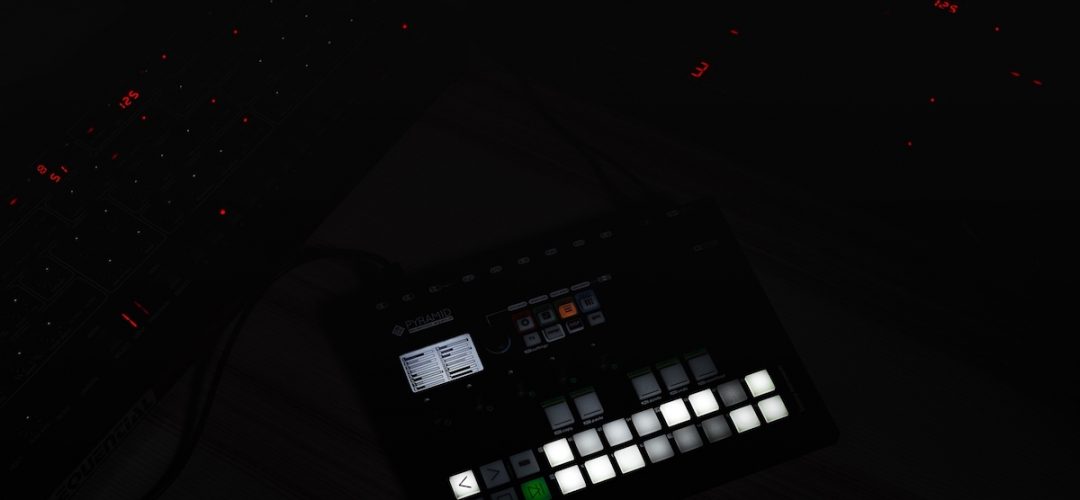The Squarp Pyramid Mk3 sequencer is considered ‘the perfect brain for your musical setup, from studio to stage.’ It combines a powerful 64-track sequencer, a looper, a rhythm generator, a real-time effects processor, a MIDI controller, and an I/O interface.
To be clear, Pyramid does not produce sounds itself. Instead, Squarp focused on building an innovative sequencing solution full of creative tools.
Squarp Pyramid Overview
Wiring Up
First, you’ll want to connect the Squarp Pyramid to the supplied mini USB power supply, or connect it to a computer with a standard mini USB cable for bus power.
It’s good to note that the sequencer can be used as a standalone unit, without being hooked up to a computer/DAW, via the included power supply.
Sequencer Workflow
Squarp Pyramid provides 64 tracks. A track is a loop that contains polyphonic or monophonic notes, automation, and effects. It will play repeatedly and controls instruments connected to MIDI A, MIDI B, USB MIDI, or CV outputs on the hardware.
The whole Pyramid workflow is designed around muting and unmuting tracks to build sequences (group of tracks). Moreover, you can create up to 32 patterns (P1, P2, …) per track to add variations to your sequences.
Pyramid allows you to easily produce your tracks from scratch with powerful creative tools, like scale generators, chord harmonizers, and other real-time effects.
Tracks vs. Sequences
A Squarp Pyramid project can include up to 64 tracks. From there, tracks are organized into 4 banks: A, B, C, D. Each bank contains a group of 16 tracks.
All 64 tracks and 4 banks are organized from TR01A to TR16A (track 1 through 16, bank A) up to TR01D to TR16D (track 1 through 16, bank D).
Each track can be configured according to your needs. A track can be:
- a standard pattern (e.g., a 4-bar track)
- a linear clip (e.g., a 384-bar track)
- a euclidean pattern
- a polymetric pattern (e.g., a 1+1/4-bar track)
- a polyrhythmic pattern (e.g., an 8-bar track with 7/8 time signature)
- a micro track with a high zoom resolution (e.g., a 1/4 bar track with 1600% zoom)
A Squarp Pyramid project can then be composed of up to 32 sequences. A sequence defines the mute states of each of the 64 available tracks. In each sequence, you choose which track is unmmuted (active) or muted (inactive) in order to build your song or arrange your set.
When the sequence changes, if a previously active track is still active in the next sequence, it will not restart from the beginning like a classic sequencer. It will continue to play & loop and therefore keep its shift with the other tracks, to keep the polymetry running. If you want to restart your track from the beginning like a classic sequencer, configure your track in ‘relatch mode.’
Pyramid’s 4 Modes
Squarp Pyramid contains the following 4 modes:
Live: use pads to play notes and automation in real time
Step: use pads to play notes and automation one step at a time
Track: mute/unmute tracks
Sequence: create and arrange structure
Live mode lets you record notes and CC automation to the current track using the built-in keypads, smartpads (8 pads that can be configured as chord generator, note repeat or scaled piano), an attached MIDI controller, a CV instrument, or your computer.
Step mode lets you fill steps of the current track with notes and chords using the 16 pads of the NOTE & CHORD stepmodes. The display includes a piano roll editor. There are also Effects stepmode, CC Messages stepmode, and the Euclid stepmode which allows for complex polyrhythms — this is not possible with most traditional sequencers.
Track mode lets you mute/unmute the tracks using the 16 pads. You can also change the current BANK (A/B/C/D), as well as set up the length, time signature, zoom, and MIDI channel of the current track. This mode is primarily about building song structure.
Finally, Squarp Pyramid’s Sequence Mode lets you launch sequences (stored mute states of the 64 tracks) on the fly, or program a chain of sequences to create a complete structured song.
Conclusion
This is just a general overview of the Pyramid’s complex and complete functionality. As a hub for both the studio and the stage, this device offers virtually limitless control of multiple instruments. For more in-depth information, visit Squarp here!
